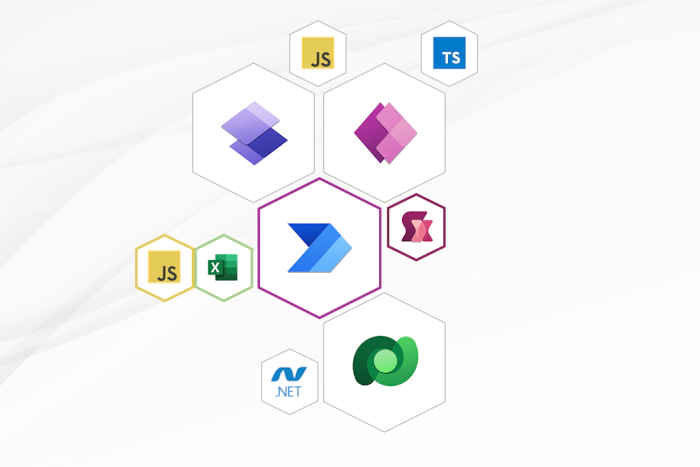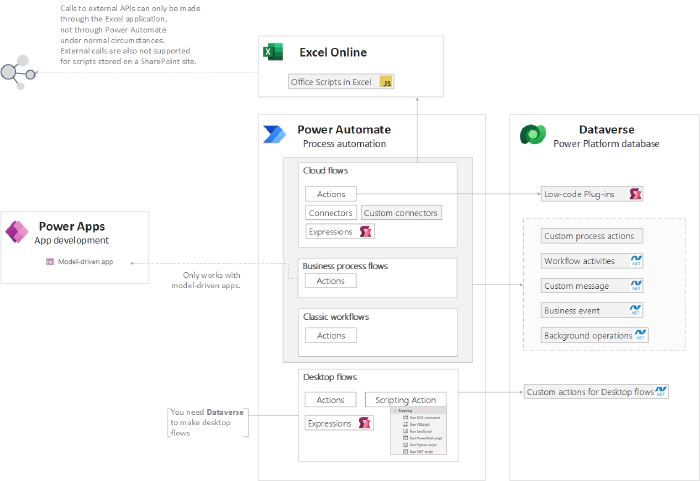
Power Platform extensibility options in Power Automate
Power Platform extensibility options series
- Power Platform extensibility options
- Power Apps
- Power Automate - this article
- Dataverse
Where to place logic
Power Automate Cloud flows are always asynchronous, while Classic workflows may be either background (asynchronous) or real-time (synchronous) workflows. Microsoft recommends to use Cloud Flows instead of classic background workflows.
Power Automate supports transactions through ChangeSets which can be used with the Dataverse connector to perform atomic transactions. For transactions not related to Dataverse, custom rollback logic must be implemented.
Power Automate can function autonomously as a workflow triggered manually, on a schedule, or by an event such as the arrival of an email or the creation of an item in a list. It may also be used to execute business logic that is not intended for client-side execution within Power Apps.
Power Automate is great for use cases where you need to run complex logic, need multiple connectors, or you don’t want the user to wait for the action to finish. Consider it if:
- Logic needs to run across multiple connectors.
- You’re creating an approval process.
- Output is being produced in another format.
- You want to reduce dependency on device-side processing power.
- The process is well understood and consistent, runs frequently and there’s a potential ROI
- High risk and/or impact of a failure could be mitigated through automation.
It’s recommended to build separate flows instead of a single automation that covers the entire process.
Key developer extensibility points
- Create custom connectors to communicate to your external data sources and services. A custom connector is a wrapper around a REST API and can be created using tools like Azure Functions and Azure API Management
- Use workflow definition functions to build complex expressions
Source: Introduction to Microsoft Power Platform for developers
Summary of extensibility options in Power Automate

See full resolution here
| Cloud Flows | Desktop Flows | Business Process Flow | Classic workflows | ||
|---|---|---|---|---|---|
| Formulas - Power Apps | Power Fx | ✅ | ✅ | ❌ | ❌ |
| Low-code plugins | Power Fx, Connectors | ✅ | ❌ | ❌ | ❌ |
| Custom process action | declarative | ✅ | ❌ | ✅* | ✅ |
| Custom API | .NET | ✅ | ❌ | ❌ | ✅ |
| Workflow activities/assemblies | .NET | ✅ | ❌ | ✅ | ✅ |
| Custom connectors | REST API | ✅ | ✅ | ✅** | ❌ |
| Office Scripts in Excel | TypeScript | ✅ | ❌ | ❌ | ❌ |
| Custom actions for Power Automate for Desktop | .NET | ❌ | ✅ | ❌ | ❌ |
| Custom script in Desktop flows | DOS command, VBScript***, JavaScript, PowerShell, Python, .NET | ❌ | ✅ | ❌ | ❌ |
* To allow business process flow execute the custom process action, define table entity and enable “As a Business Process Flow” in action properties
** By using custom process action that uses custom connector
*** VBScript is deprecated from Windows
Formulas using Power Fx
Read more: Formulas
Formulas combine many elements, for example:
- Functions: take parameters, perform an operation, and return a value. Functions are modeled after Microsoft Excel functions. Some functions have side effects, such as
SubmitForm, which are appropriate only in a behavior formula such asButton.OnSelect. - Signals return information about the environment. For example, Location returns the device’s current GPS coordinates. Signals don’t take parameters or have side effects.
- Enumerations return a pre-defined constant value. For example, Color is an enumeration that has pre-defined values for
Color.Red,Color.Blue, and so forth. - Named operators, such as ThisItem and Self, provide access to information from within a container.
Constraints and limitations
Not all functions area available in all Power Platform components. For example regular expressions like IsMatch, Match, and MatchAll are available in both, Canvas and Model-driven apps but not in Power Automate.
Low-code Plug-ins using Power Fx
Read more: Low-code Plug-ins
With the low-code plug-ins, you can create plug-ins with minimal or no coding required, and without the need for compiling solution and manual registration.
Low-code plug-ins are stored within a Dataverse database and can be seamlessly integrated into Power Apps and Power Automate. They are defined using the Power Fx expression language and can directly connect with Dataverse business data and external data sources through Power Platform connectors.
Idea: You may use low-code plugins as a way to execute regular expressions in Power Automate.
Constraints and limitations
Low-code plug-ins are stored within a Dataverse database and are created using Dataverse accelerator app, which must be installed in the environment. All new environments have the Dataverse accelerator app automatically installed as of October 1st 2023.
Use of low-code plugins in your solution requires Premium licenses.
Custom process actions (declarative)
Read more: Custom process action
Custom process actions, also known as Custom actions, allow creating custom reusable actions that encapsulate specific business logic, and may be invoked directly from a workflow.
The business logic of a custom process action is implemented using a workflow. When you create a custom process action, the associated real-time workflow is automatically registered to execute in the main operation stage of the message execution pipeline. They are stored in Dataverse and may use a context of a table, or be defined as global.
See Dataverse page for a more details.
Constraints and limitations
To allow business process flow execute the custom process action, define table entity and enable As a Business Process Flow in action properties
Custom API using .NET
Read more: Custom API
Custom API is a newer way to define custom messages with many advantages for developers. If you do not intend to use the no-code capabilities that custom process actions provide to configure business logic, custom API provides better capabilities for developers to create their own messages.
See Dataverse page for a more details.
Constraints and limitations
Compare Custom Process Action and custom API
Workflow activities/assemblies
Read more: Workflow activities/assemblies
As reusable components, workflow extensions can be added to any workflow or custom action.
See Dataverse page for a more details.
Custom connectors using REST API
Read more: Custom connectors
Use to communicate to your external data sources and services. A custom connector is a wrapper around a REST API and can be created using tools like Azure Functions or Azure API Management.
New connectors-both Microsoft first party and third party-are added constantly, and as an administrator you should be aware of new connectors and ensure they are classified accordingly in your Data loss prevention (DLP) policies
Constraints and limitations
Power Platform only supports REST API, while Logic Apps also supports SOAP APIs.
Custom connector FAQ for Azure Logic Apps, Power Automate, and Power Apps
Office Script in Excel using TypeScript
Read more: Office Script in Excel
Office Scripts in Excel let you automate your day-to-day tasks. You may record manual steps, or write your script on your own.
Although it’s meant for editing workbook, you don’t have to access Excel contents at all. Instead, you may use Office Script in Excel to execute your TypeScript functions, to execute any logic that is not available using Power Fx.
Constraints and limitations
To use Excel Online (Business) connector (standard) in Power Automate you must have a business license of Microsoft 365
Excel Scripts may be saved either in OneDrive or in a SharePoint
Requests and responses in Excel are limited to 5MB, and the maximum size of parameters passed to the Run script action is 30,000,000 bytes (28.6MB).
External calls from a script are NOT supported
Data security in Office Scripts with Power Automate Limits and configuration in Power Automate Known issues and limitations for the Excel Online (Business) connector Power Automate specific restrictions TypeScript restrictions in Office Scripts
Custom actions for Power Automate for Desktop using .NET
Read more: Custom actions for Power Automate for Desktop
Custom actions exist at the environment level. Custom actions developed by your organization and uploaded to the respective environments can be included in desktop flows and utilized like actions that belong in the standard library of automation actions.
Constraints and limitations
.dll files describing Custom actions, their dependency .dll files, and the .cab files are properly signed with a digital certificate trusted by your organization. The certificate should also be installed on the device under the trusted root certificate authority where the desktop flow with custom action dependencies is modified and/or executed.
Custom script in Desktop flows
Read more: Custom script in Desktop flows
Scripting actions enable you to run blocks of code and implement custom behavior in your desktop flows using:
- DOS command,
- VBScript*,
- JavaScript,
- PowerShell,
- Python and
- .NET.
* VBScript is deprecated from Windows. In future releases of Windows, VBScript will be available as a feature on demand before its removal from the operating system
Constraints and limitations
To prevent unauthorized access, Windows require administrator rights to access protected resources. To access protected resources (such as files) using the scripting actions, run Power Automate with administrator rights.